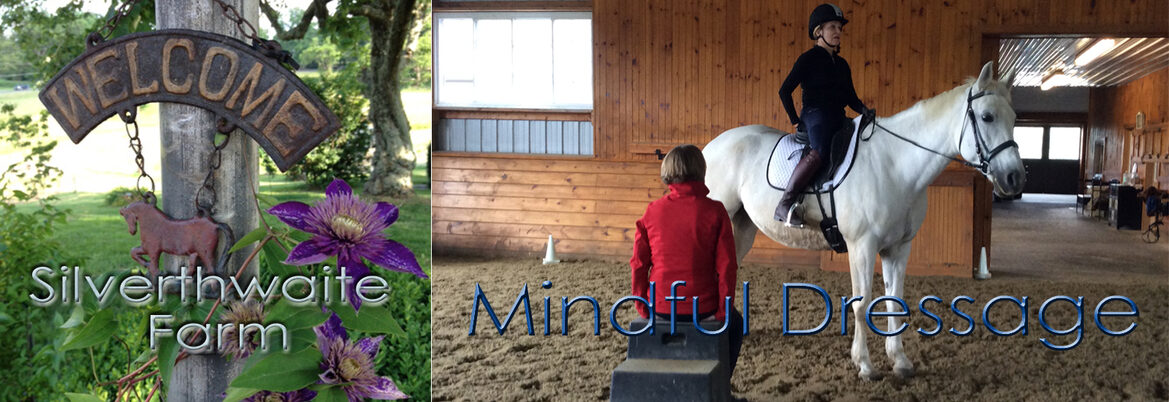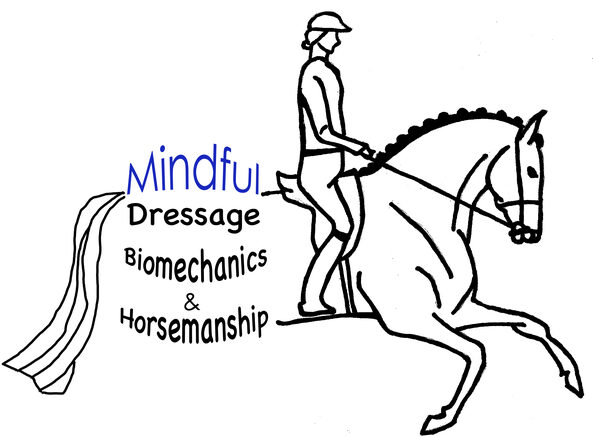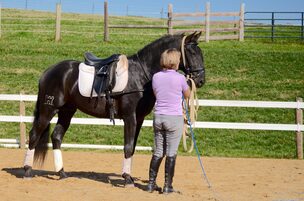A Holistic Approach for Horse
and Rider
The goal of my program is to help develop a skilled, knowledgeable and thinking rider, who rides with awareness and feel, thus creating a harmonious relationship with their horse and a happy athlete.
I love to teach and take pleasure helping all levels and ages of both horses and riders, whether they ride for pleasure or for competition.
The main elements of my system are:
- To improve your horses' gymnastic abilities with traditional Dressage movements, patterns and poles exercises;
- To improve skill, awareness and feel in the rider, through an understanding of correct biomechanics and use of the rider’s seat and core;
- To develop softness, confidence and flexibility, in your horses' physical and mental state through correct use of effective ground work and in-hand exercises and lunging ;
- Develop over-all awareness of the horses welfare with regards to gut health, feed, saddle fit and muscle/bodywork.
- To set attainable short/long term goals whether aiming towards pleasure riding or competitive sport.
DRESSAGE is defined by the USDF as :-
“The object of dressage is the development of the horse into a happy athlete through harmonious education. As a result, it makes the horse calm, supple, loose and flexible but also confident, attentive and keen, thus achieving perfect understanding with the rider”.
Dressage should not look or feel like the rider is ‘STUFFING AN ELEPHANT INTO A SUITCASE'.
Correct Dressage training is beneficial for all horses regardless of their discipline. It is a process that takes time, knowledge, understanding and fair ethical riding. So, the rider needs knowledge of the ‘what, when and why” of the movement or exercise as well as “the how to”.
This leads us into the world of Rider Biomechanics and how our body influences the horse in both negative and positive ways.
BETTER BIOMECHANICS = BETTER PERFORMANCE
I use streamlined corrections for the rider, taught in’ bite-sized chunks’, using words, images and a ‘hands on’ kinetic approach, and have the rider note the positive ‘feedback’ from the horse when correctly applied. Not always a ‘quick fix’ but it is doable and sustainable and will significantly improve the rider’s skill and influence on the horse.
Correct Biomechanics will:
- Develop better awareness and feel
- Correct body asymmetry and body parts that misbehave
- Help you and your horse develop self-carriage
- Enable you to put your horse ‘on the bit’ correctly, without fiddling your horses’ head down
- Enable you to ‘pick up your horses back’ from your core
- Teach you the ‘cause and effect’ and ‘how to’ of riding
- Bring your riding skill to a new level
- Improve your dressage scores
- Develop a better partnership with your horse.
All levels of riders will benefit from this approach and it is often the “ICING ON THE CAKE’.
WORKING IN-HAND
Effective In-hand work.... From pasture to competition
Traditional training promotes the use of lunge and long line work with youngsters prior to saddling and shortly thereafter with “fresh horses”. Once horses really get going under saddle many riders rarely go back to these useful training tools. In addition, riders often don’t consider “natural horsemanship” as correct, necessary or relevant, especially in the world of dressage. This skill set is easily integrated into an existing training routine. I have found that adding a mix of these methods has a profoundly positive effect on the horse’s mental and physical state. And the benefits of unmounted work are carried over into ridden work.
Some benefits are:-
-
A way for the horse to learn “how to” move through their bodies without the weight of the rider, helping balance and self-carriage – Horse yoga – The horse becomes ‘a Limbo dancer not a Line dancer’
-
A very tense, spooky or stiff horse finds a way to mentally and physically soften and then seeks to find the relaxed sensation when under pressure – developing confidence through the process
-
Gives the rider a chance to observe and connect with their horse in a different way - change of mindset for both horse and rider
-
Correct lunging/long lining gives rider a chance to observe movement and biomechanics of their horse
- In-hand exercises can show horses how to become more expressive and increase range of leg motion, athletic development e.g. leg lifts, piaffe etc


